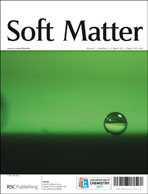Wormlike micelles and gels reinforced by hydrogen bonding in aqueous cationic gemini surfactant systems†
Abstract
The viscoelastic properties of the wormlike micellar solutions of 2-hydroxyl-propanediyl-α,ω-bis(dimethyldodecylammonium bromide) and 2-hydroxyl-propanediyl-α,ω-bis(dimethyltetradecylammonium bromide), abbreviated as 12-3(OH)-12 and 14-3(OH)-14, respectively, have been investigated using steady state and frequency sweep rheological measurements. For comparison, the wormlike micellar solutions of propanediyl-α,ω-bis(dimethyldodecylammonium bromide) (referred to as 12-3-12) were also examined on an identical level. Steady state rheological measurements revealed that at low concentrations, the zero-shear viscosity of the 12-3(OH)-12 system was far higher than that of the 12-3-12 system. From dynamic rheological data, the characteristic parameters were drawn out using the Maxwell fluid model and the viscoelastic rheological behavior was discussed according to the living


 Please wait while we load your content...
Please wait while we load your content...